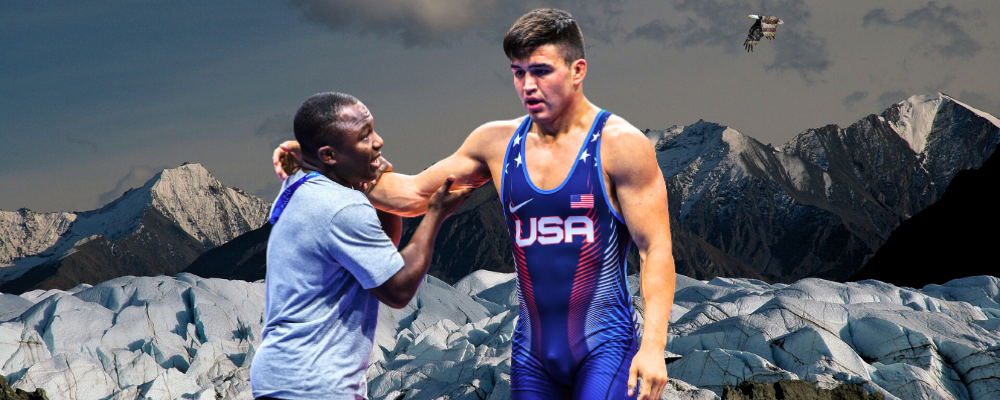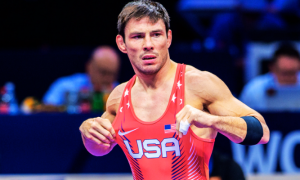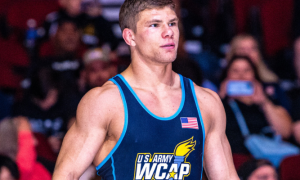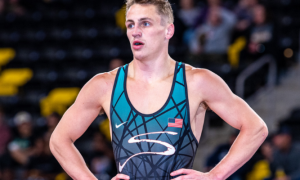This is the third and final installment of a series aimed at exploring the weight categories athletes might choose in effort to make the 2024 USA Greco-Roman Olympic Team. As explained previously, Senior wrestling seasons that end with a World Championships avail ten weight categories — four of which hold a non-Olympic designation. The Olympic Games are contested in only six such weight classes, thus forcing wrestlers in non-Olympic categories to decide whether they will “bump up” or “drop down” to the Olympic weight they feel offers the best fit.
In Part I, athletes from the two lightest non-Olympic classes (or “World weights”) were discussed, but only one category — 63 kilograms — invited enough conjecture to warrant detailed projections. That is because, barring drastic size increases, all of the wrestlers at 55 kg are expected to simply move up to 60. For Part II, 72 kilograms was the lone weight category highlighted. Part III covers 82 kg, which is slotted between Olympic weights 77 and 87 kg.
2024 USA Olympic Team Selection
Words one might use when it comes to the temporary removal of the aforementioned four weight classes in advance of an Olympiad are “consolidation” and “absorption”. These terms best describe what occurs when narrowing ten weight categories down to six. The weight classes are, in fact, consolidated — and four of the six Olympic weights absorb four non-Olympic (or “World” weights). The number is four, not six, because 97 and 130 kilograms are naturally unaffected by this process (unless you are in Hungary).
OLYMPIC WEIGHT CATEGORIES
60 KG
67 KG
77 KG
87 KG
97 KG
130 KG
Qualifying Opportunities
The Bill Farrell Memorial in November should provide some answers for the US program relative to the athletes who have recently competed in non-Olympic weight classes. As is custom, the highest-placing American (top-4) in each bracket, who has not yet qualified, will receive a berth in the Olympic Trials. For those competitors who do not travel to New York, the Nationals in Fort Worth, Texas are available four weeks hence; and that tournament will deliver five more Trials contestants per weight category.
Other avenues for wrestlers to qualify for the Olympic Team Trials are:
- Top-2 from the Armed Forces Championships (February).
- First place from the NCAA Division I National Championships (March).
- First place from the “Last Chance OTT Qualifier” (March).
Gold medalists from the Pan-Am Championships (which take place one week prior to the Pan-Am Olympic Qualifier in Santiago, Chile) also obviously secure bracket positions in the Olympic Trials — but it is quite likely that those athletes who make the US roster will have already locked down their spots in the aforementioned Trials. The same can be said for the continental Olympic Qualifier itself.
Projected Weight Class Movement
82 KG
This past season, 82 kilograms was the most competitive upper-weight category in the United States. Objectively, the bracket’s depth provided a substantial amount of close, compelling match-ups throughout the spring selection process, a process that concluded with a thrilling three-match series between eventual winner Spencer Woods (Army/WCAP) and Ryan Epps (Army/WCAP) at Final X: Newark. Subjectively, the number of participants was surprising and, in the eyes of some, not exactly ideal. Due to ’23 selection culminating with the chance for the US to qualify Olympic weights at the World Championships, the expectation prior to the season was that most of 82’s heavy hitters would move up to 87 in preparation to take on that task-set. That’s not how it went, of course, and 87 failed to boast as many contenders as non-Olympic 82.
There is no such choice for athletes now that the Olympic Year has fully arrived. 87 kilograms is projected to absorb most of the lot from 82, but 77 will rake in a few names, as well.
Woods will be returning to 87 kilograms at the end of November for the CISM Military World Games in Baku, Azerbaijan. That news would seem to answer any and all questions regarding his weight category for this Olympic Year — yet it does still feel as though an argument could be made for 77. Remember: Woods had tried out the lighter of the two weight categories back in ’19, and promptly qualified for the Tokyo Olympic Trials after placing second at 77 in that year’s Bill Farrell Memorial. But the following spring, “The Alaskan Assassin” joined the Army, moved to Fort Carson following basic and AIT, and soon committed his efforts towards 87. In what was his first Olympic Trials appearance, Woods performed well and advanced to the third-place/National Team match (where he was edged by three-time World Teamer Patrick Martinez). Later that same month, he won his first Senior National title. A jaunt back down to non-Olympic 82 for the ’21 World Team Trials was next, and so it has been over the past two seasons. It has always been the anticipation that 87 is where he would wind up once again. But, maybe not, even with CISM just over a month away.Woods reportedly considered 87 for the ’22-’23 campaign in order to get a head start for this season — but relented due to his low “walking around weight”. Whatever that number is or was, Woods apparently found that the juice was more worth the squeeze to focus on 82 this year. Given that he made the World Team, it is hard to argue with the call. But it is also because of that justification why, perhaps, 77 for Woods might not be totally out of the question. If Woods had felt that he were a little light for 87 in ’23, would a five-kilo reduction — despite the prospect of same-day weigh-ins — loom large in his mind as some sort of dealbreaker? Of course, none of this likely on the table at all with which to begin. Woods is certainly appropriately-suited to contend at 87, is already slotted to make a start at that weight, and the current projection is that is exactly from where he will do business in ’24. But it’s fun to imagine how he might fare at 77 just the same. (UPDATE: Woods is no longer entering the Military World Games; ’20 Olympic Team member John Stefanowicz has instead been awarded the spot due to his belonging to a service branch whilst occupying the Olympic weight of 87 kg this past season.)
One main reason why Ryan Epps (Army/WCAP) is expected to go 87? His musculature. Epps is a strength-training enthusiast of the highest order and is constantly packing on muscle without compromising functionality. He knows what he is doing to his body when he does it. There is also a timing factor. Epps chose 77 when he first began competing on the Senior circuit in ’20. He was rather massive for the weight class back then, though not so big that 87 made sense — although that did not stop him from hitting up 87 for the ’21 World Trials, which for him was a more-than-solid tournament considering that he had made the best-of-three final opposite Alan Vera (NYAC). However — Epps had decided on a virtual whim to bump up to 87 for that event. He originally set his sights on 77 but determined that he had a better shot of making noise one weight class north. And following that season, 82 became his home. Three years, give or take, is a long time. Epps was fresh out of college in ’20 and trying to assimilate as a full-time Greco competitor. He is a bit bulkier these days but none of that size appears up for grabs. Can Epps make 77? Sure. But can he compete at 77 to his fullest physical potential (i.e., without depleting precious reserves)? Tough to picture.
An entire chapter of a book could be written about Ben Provisor‘s (NYAC) decision to go 77 for the Tokyo selection process. It was something else. Everyone was invested in that story. Because, nearly all of us got carried away with imagining his 87 kg body battling against smaller 77’s. We also figured that since he had established himself at 74 kg nine years prior, a same-day weigh-in at 77 might not be a bridge too far, even when considering his expanded frame. That isn’t to suggest there was zero accounting for diminishment. The thought was that Provisor would have to temporarily say goodbye to at least some muscle mass. Maybe his tree-trunk legs would narrow a touch, maybe his enormous back and shoulders would crease inward ever so slightly. And, Provisor handled the whole thing like a pro. He really did. He started his descent pretty much in the fall of ’19 and kept a disciplined diet throughout the proceeding 18 months (the onset of the pandemic did not derail his motivation). Provisor did the absolute best that he could to hit the mark and get on a third Olympic Team. In the end, his body was unable to remain optimized in conjunction with the weight loss. 82 kilograms after the Olympic Trials? Right in his wheelhouse. “Big Ben” made consecutive World Teams in the class following his one-tournament appearance at 77. But here’s the rub: when Provisor eyeballed 77, part of his rationale was that he had been a little undersized (height-wise) for 87. Well, he had won an Open title and twice finished second at the World Team Trials in that weight class, thus rendering his proclamation a difficult sell. The truth is that Provisor most assuredly would have had quite a very legitimate chance at 87 kilos in the Tokyo Trials and in each tournament henceforth. His subsequent venture down to non-Olympic 82, aside from finishing second to both Woods and Epps this past season, wasn’t a bad experience. But that ride is over, perhaps for good, and Provisor, again, belongs at 87. His age, 33, is a non-factor given that plenty of top international athletes in the upper-weights are in the same range. This weight division, one that he did not have to abandon, is where he can do the most damage and fitfully seek a third trip to the Olympics.
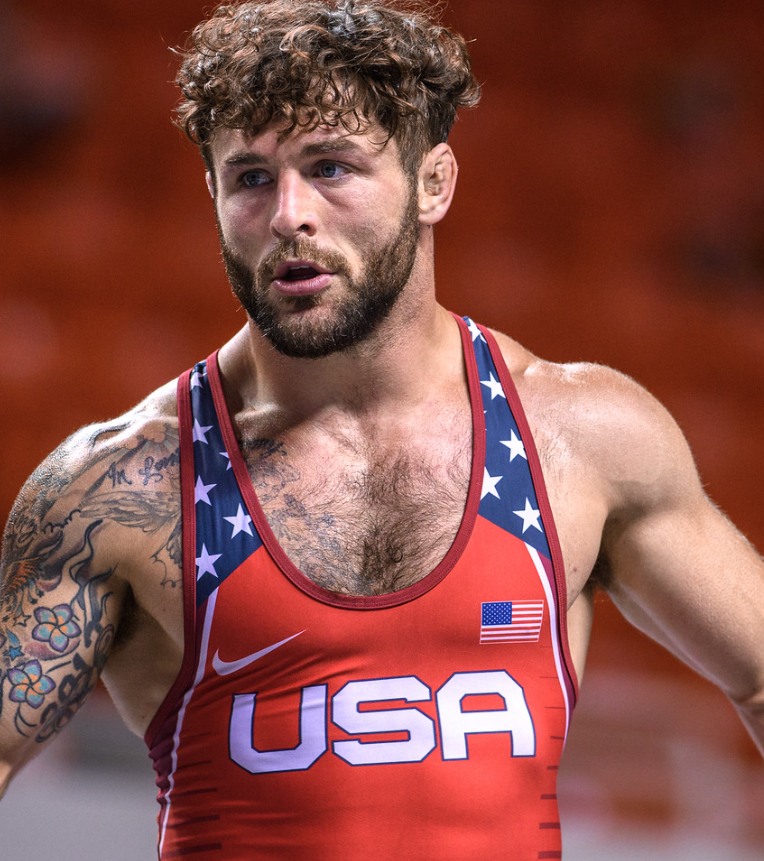
Two-time Olympian and multi-time World Team member Ben Provisor likely does not have a question mark attached to his weight class for the 2024 US Olympic Trials. Although the decorated upper-weight did throw his hat into the ring at 77 kg for the Tokyo selection process, the anticipation for the end of this cycle is that Provisor will return to 87 kg. (Photo: Tony Rotundo)
Four years ago, ’18 Junior World silver Andrew Berreyesa (NYAC) gave 77 kg a whirl. He looked very good in that weight class, wrestled and won a few very good matches, but then there was the whole COVID thing followed by the same sort of hiatus that affected the entire sport. It actually was not a jolting surprise when, in ’21, Berreyesa attempted to qualify for the Olympic Trials up a weight class. He wore 87 well and had a solid run at the Last Chance Qualifier. He went back on the Greco shelf after that for a while, what with finishing up at Cornell and heading out west to the University of Northern Colorado. Berreyesa came back to the proper style this past spring at 82 kilos and it was as if he had never taken a break. He advanced all the way to the US Open semifinal and pressed Provisor throughout the entirety of their match, only to fall 4-3. He then walloped old pal Tommy Brackett (NYAC) with a headlock before going over Johanner Correa (NC) to grab third place. This was how Berreyesa fared in his first Senior tournament in over two years. Epps and Barrett Stanghill (Minnesota Storm) both clipped him in the Trials, but that doesn’t wax any of the shine off of the impression made at the Open. So, this is all academic. Berreyesa performed impressively at 82 kilograms, which had been at one time familiar territory for him. Is dropping down thus advisable? No, it is not. Berreyesa is a problem for opponents because he pummels furiously and with a purpose, and deftly follows with his feet, only creating static when it is worth his while insofar as position is concerned. He enjoys motion. Not everyone in this division does. And if he is going to defend from par terre (which was a big part of his making the Junior World final), a little more body mass at 87 is better-suited for him as opposed to a little less from shrinking down for 77.
Brackett is not thought to be interested in 77 kg, which is understandable. Other than a few starts over half a decade ago in the old 75 kg division (with day-before weigh-ins), and a brief stint at new 77 in ’19, the Tennessee native has stuck with 82/87 as his AO. Brackett is on the shorter side of the height spectrum in this range and the reason why that is disadvantageous for him in particular is due to his style. Few Seniors in the country exhibit as much positional discipline as he, yet the guy has been banged for an exorbitant amount of untimely cautions by US refs because a) they don’t know what underhooks are supposed to do, and b) most of his opponents are markedly taller and stuff his head, or get away with bailing out on ties that leave him clinging and reaching to close that empty space in transition. On sheer optics, Brackett eats a lot of the blame for these histrionics, and it is fair to question if he would be victimized by such tactics in the 77 class, where the tempo is crisper and attempts are more common. Then again, Brackett does not abide as high of a pace as the lighter athletes. The rhythm 87 offers is the more obvious fit and it wouldn’t be unfamiliar. Brackett made a National final at 87 along with having competed in the class several times overseas. Barring a shocking development, that is where you will find him this fall.
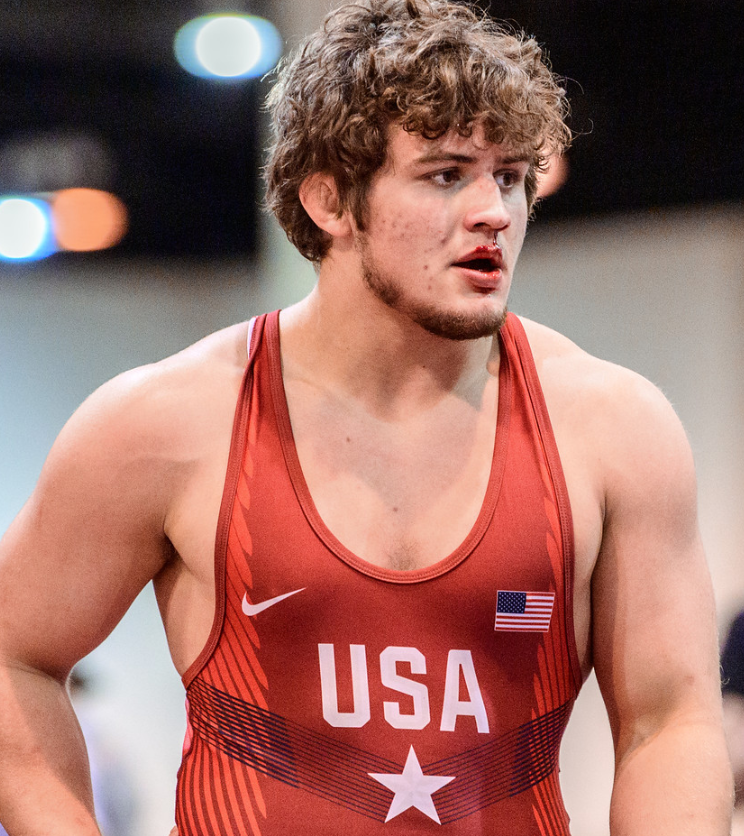
Tommy Brackett, a U23 World Team member in 2021, has spent the majority of his still-young career in the 82 kg category. He was also a National finalist at 87 kg that same year. (Photo: Tony Rotundo)
There is a difference between “plausible” and “possible”. For ’23 U23 World Teamer “Turbo” Ty Cunningham (NYAC/MWC), 77 kg is possible. But plausible? Only he and his coaches know the answer to that question. Cunningham — beholden to rather huge neck — was very much a monster-type at 82 and brandished solid horsepower in his offense. He also became one of Vera’s go-to workout partners. If he could hang in with Vera during practices, and has grown accustomed to what that athletic freak brings to bear, then it’s not a stretch to surmise that the rest of the 87 field probably fails to move his mercury. Cunningham would have a lot to offer in what should be the deepest upper-weight division in the US, and the potential match-ups waiting for him there are extremely intriguing. We’ve already seen Cunningham battle most of the 82’s, but no one would mind seeing him against ’23 World Team member Zac Braunagel (IRTC), Timothy Young (Army/WCAP), and ’20 Olympian John Stefanowicz (Navy WC). However, 77 is also available. Cunningham does not walk around heavy. His size at 82 is deceptive. Word is that he had room to breathe making weight. Does this mean 77 is on his radar as much, or more so, than 87? If so, then the pairings we might see come tournament time are equally ridiculous. Cunningham versus the likes of Kamal Bey (Army/WCAP), RaVaughn Perkins (NYAC), Britton Holmes (Army/WCAP), Benji Peak (Sunkist/NTS), and Patrick Smith (Minnesota Storm) would be can’t-miss theater. Since Cunningham is on an upwards trajectory, he can be a player in either weight class.
When it comes to multi-time National champ Kendrick Sanders (NYAC/NTS), it’s easy: should Sanders heartily invest in making the Olympic Team, he will be at 77. If not, expect to see him at 87 — or not at all. It’s vexing. Sanders is, and has been, one of the most capable, skilled, and overall best wrestlers in the United States for over a decade. There is nothing anyone can do that he cannot, and chances are he does everything better. But life has changed for Kendrick, and it has become even more difficult for him to commit to competition than it even was in the past. You root for him to make a run here. After this quad is through, it’s unlikely that he will be game for another one. Or, Kendrick will still pop in sporadically, thump a few dudes, and ease back into the shadows.
Fritz Schierl (Minnesota Storm) has spent more time at 77 kilograms than any other athlete discussed in this space with the exception of Sanders. The ’22-’23 season, his first with the Storm, brought upon his departure from the Olympic weight. Schierl had some laudable moments to be sure but, for whatever reason, never really caught fire at 82. On its face, it was actually surprising. We’re talking about a very good, aggressive scorer with a great deal of meaningful experience domestically (such as having been a Trials finalist in ’21) but he struggled in spots, and in unexpected fashion. Schierl did not look undersized for 82. It just felt like something was missing. Chalk it up to an adjustment period going from Ohio State to Minnesota as well as trying on the heavier weight category. For now, we’re not reading into his foray at 82 as a test drive before moving up to 87; instead, the perception is that it was merely a detour. ’24 should mark Schierl’s resumption as a 77 kg contender, and a serious one at that.
*Already qualified for 2024 Olympic Team Trials.
*’23 World Team member — Spencer Woods (Army/WCAP) — 87 kg
’23 Final X runner-up — Ryan Epps (Army/WCAP) — 87 kg
*’23 WTT 3rd Place — Ben Provisor (NYAC) — 87 kg
Khalil Abdushshakur (Morris Fitness WC) — 87 kg
Andrew Berreyesa (NYAC) — 87 kg
Tommy Brackett (NYAC) — 87 kg
Johanner Correa (NC) — 87 kg
Ty Cunningham (NYAC/MWC) — 87 kg
Lukas Poloncic (Minnesota Storm) — 77 kg
Kendrick Sanders (NYAC/NTS) — 77 kg
Fritz Schierl (Minnesota Storm) — 77 kg

Listen to “5PM54: WCAP’s Ryan Epps and a Final X Greco-Roman Preview” on Spreaker.
SUBSCRIBE TO THE FIVE POINT MOVE PODCAST
iTunes | Stitcher | Spreaker | Google Play Music


